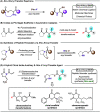N-to- S Acyl Transfer as an Enabling Strategy in Asymmetric and Chemoenzymatic Synthesis
- PMID: 38818054
- PMCID: PMC11134368
- DOI: 10.1021/jacsau.4c00257
N-to- S Acyl Transfer as an Enabling Strategy in Asymmetric and Chemoenzymatic Synthesis
Abstract
The observation of thioester-mediated acyl transfer processes in nature has inspired the development of novel protein synthesis and functionalization methodologies. The chemoselective transfer of an acyl group from S-to-N is the basis of several powerful ligation strategies. In this work, we sought to apply the reverse process, the transfer of an acyl group from N-to-S, as a method to convert stable chiral amides into more reactive thioesters. To this end, we developed a novel cysteine-derived oxazolidinone that serves as both a chiral imide auxiliary and an acyl transfer agent. This auxiliary combines the desirable features of rigid chiral imides as templates for asymmetric transformations with the synthetic applicability of thioesters. We demonstrate that the auxiliary can be applied in a range of highly selective asymmetric transformations. Subsequent intramolecular N-to-S acyl transfer of the chiral product and in situ trapping of the resulting thioester provides access to diverse carboxylic acid derivatives under mild conditions. The oxazolidinone thioester products can also be isolated and used in Pd-mediated transformations to furnish highly valuable chiral scaffolds, such as noncanonical amino acids, cyclic ketones, tetrahydropyrones, and dihydroquinolinones. Finally, we demonstrate that the oxazolidinone thioesters can also serve as a surrogate for SNAC-thioesters, enabling their seamless use as non-native substrates in biocatalytic transformations.
© 2024 The Authors. Published by American Chemical Society.
Conflict of interest statement
The authors declare no competing financial interest.
Figures






Similar articles
-
Cysteinylprolyl imide (CPI) peptide: a highly reactive and easily accessible crypto-thioester for chemical protein synthesis.Chem Sci. 2019 May 9;10(23):5967-5975. doi: 10.1039/c9sc00646j. eCollection 2019 Jun 21. Chem Sci. 2019. PMID: 31360403 Free PMC article.
-
Drug-S-acyl-glutathione thioesters: synthesis, bioanalytical properties, chemical reactivity, biological formation and degradation.Curr Drug Metab. 2011 Mar;12(3):229-44. doi: 10.2174/138920011795101886. Curr Drug Metab. 2011. PMID: 20946099 Review.
-
Reinvigorating the Chiral Pool: Chemoenzymatic Approaches to Complex Peptides and Terpenoids.Acc Chem Res. 2021 Mar 2;54(5):1143-1156. doi: 10.1021/acs.accounts.0c00823. Epub 2021 Feb 5. Acc Chem Res. 2021. PMID: 33543931 Free PMC article. Review.
-
Peptide Thioester Formation via an Intramolecular N to S Acyl Shift for Peptide Ligation.Top Curr Chem. 2015;362:107-35. doi: 10.1007/128_2014_575. Top Curr Chem. 2015. PMID: 25370522 Review.
-
Intramolecular acyl transfer in peptide and protein ligation and synthesis.J Pept Sci. 2015 Mar;21(3):139-47. doi: 10.1002/psc.2749. Epub 2015 Jan 30. J Pept Sci. 2015. PMID: 25641053 Review.
Cited by
-
An Enantioselective Decarboxylative Glycolate Aldol Reaction.Org Lett. 2024 Oct 25;26(42):9040-9045. doi: 10.1021/acs.orglett.4c03251. Epub 2024 Oct 10. Org Lett. 2024. PMID: 39388361 Free PMC article.
References
-
-
For reviews, see:
- Hirschbeck V.; Gehrtz P. H.; Fleischer I. Metal-Catalyzed Synthesis and Use of Thioesters: Recent Developments. Chem. – Eur. J. 2018, 24 (28), 7092–7107. 10.1002/chem.201705025. - DOI - PubMed
- Cheng H.; Chen H.; Liu Y.; Zhou Q. The Liebeskind–Srogl Cross-Coupling Reaction and Its Synthetic Applications. Asian J. Org. Chem. 2018, 7 (3), 490–508. 10.1002/ajoc.201700651. - DOI
- Sikandar S.; Zahoor A. F.; Naheed S.; Parveen B.; Ali K. G.; Akhtar R. Fukuyama Reduction, Fukuyama Coupling and Fukuyama–Mitsunobu Alkylation: Recent Developments and Synthetic Applications. Mol. Divers. 2022, 26, 589–628. 10.1007/s11030-021-10194-7. - DOI - PubMed
-
LinkOut - more resources
Full Text Sources
